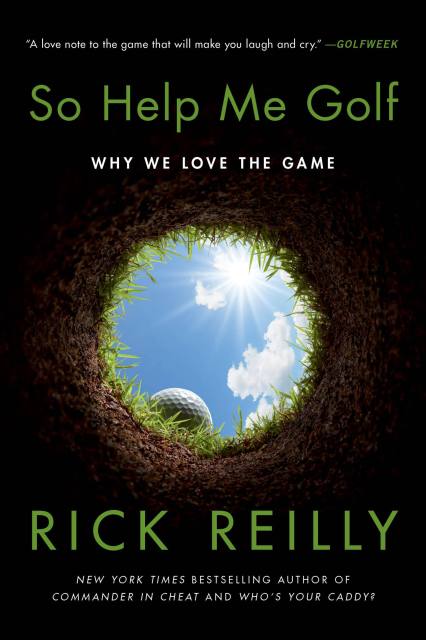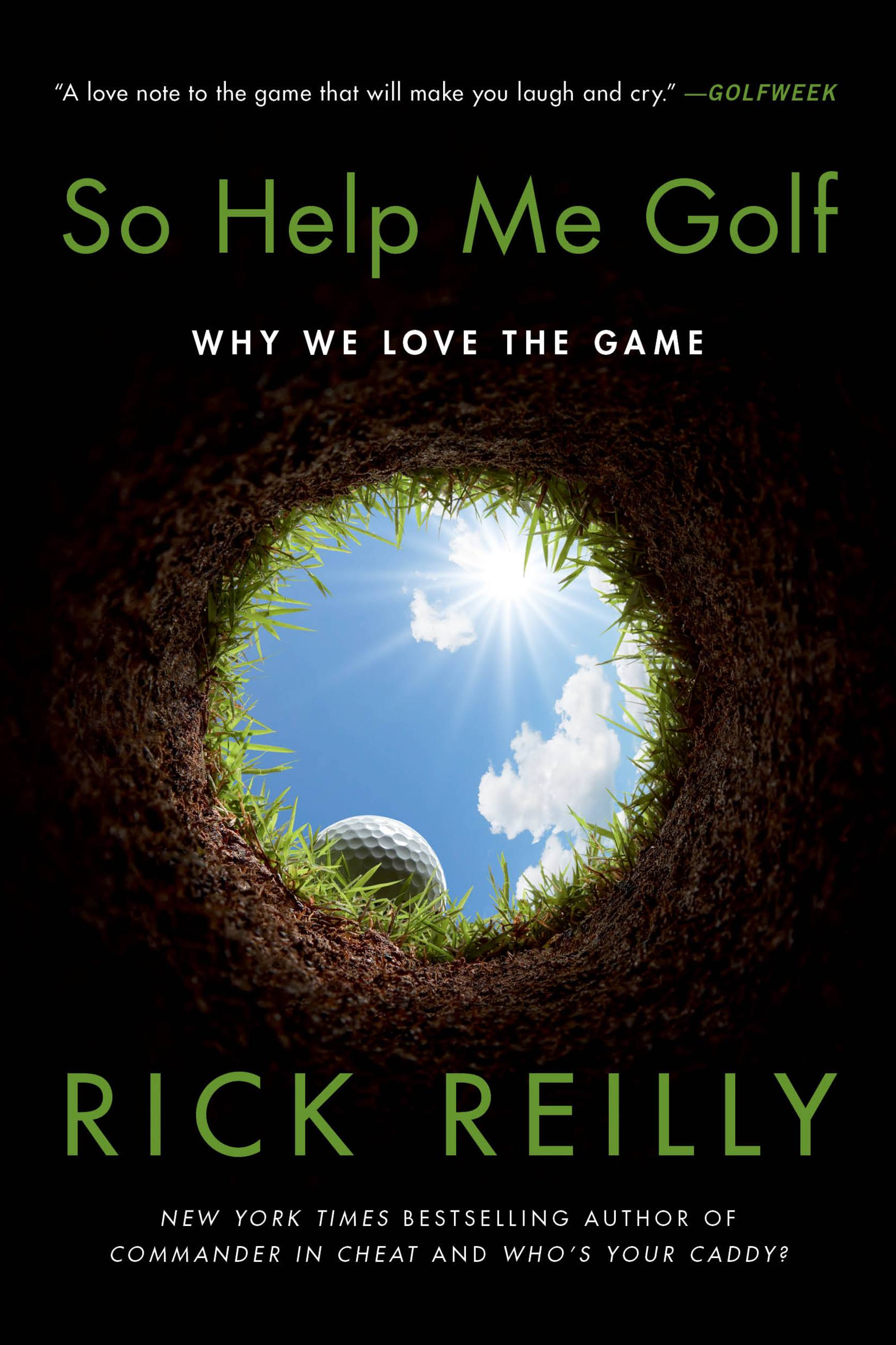Promotion
Use code BEST25 for 25% off storewide. Make sure to order by 11:59am, 12/12 for holiday delivery!
By clicking “Accept,” you agree to the use of cookies and similar technologies on your device as set forth in our Cookie Policy and our Privacy Policy. Please note that certain cookies are essential for this website to function properly and do not require user consent to be deployed.
So Help Me Golf
Why We Love the Game
Contributors
By Rick Reilly
Formats and Prices
- On Sale
- May 23, 2023
- Page Count
- 288 pages
- Publisher
- Grand Central Publishing
- ISBN-13
- 9780306924927
Price
$19.99Price
$25.99 CADFormat
Format:
- Trade Paperback $19.99 $25.99 CAD
- ebook $12.99 $16.99 CAD
- Hardcover $29.00 $37.00 CAD
- Audiobook Download (Unabridged) $24.99
This item is a preorder. Your payment method will be charged immediately, and the product is expected to ship on or around May 23, 2023. This date is subject to change due to shipping delays beyond our control.
Buy from Other Retailers:
A beloved New York Times bestselling author and golf aficionado shares his insatiable curiosity, trademark sense of humor, and vast knowledge of the game in this cavalcade of original pieces about why we love the sport, now featuring three additional new pieces.
This is the book Rick Reilly has been writing in the back of his head since he fell in love with the game of golf at eleven years old. He unpacks and explores all of the wonderful, maddening, heart-melting, heart-breaking, cool, and captivating things about golf that make the game so utterly addictive. We meet the PGA Tour player who robbed banks by night to pay his motel bills, the golf club maker who takes weekly psychedelic trips, and the caddy who kept his loop even after an 11-year prison stint. We learn how a man on his third heart nearly won the U.S. Open, how a Vietnam POW saved his life playing 18 holes a day in his tiny cell, and about the course that’s absolutely free.
Reilly mines all of the game’s quirky traditions—from the shot of bourbon you take before you tee off at Peyton Manning’s course, to the way the starter at St. Andrews announces to your group (and the hundreds of tourists watching), “You’re on the first tee, gentlemen.” He means that quite literally: St. Andrews has the first tee ever invented. We’ll visit the eighteen most unforgettable holes around the world (Reilly has played them all), including the hole in Indonesia where the biggest hazard is monkeys, the one in the Caribbean that’s underwater, and the one in South Africa that requires a shot over a pit of alligators; not to mention Reilly’s attempt to play the most mini-golf holes in one day.
Reilly expounds on all the great figures in the game, from Phil Mickelson to Bobby Jones to the simple reason Jack Nicklaus is better than Tiger Woods. He explains why we should stop hating Bryson DeChambeau unless we hate genius, the greatest upset in women’s golf history, and why Ernie Els throws away every ball that makes a birdie. Plus all the Greg Norman stories Reilly has never been able to tell before, and the great fun of being Jim Nantz. Connecting it all will be the story of Reilly’s own personal journey through the game, especially as it connects to his tumultuous relationship with his father, and how the two eventually reconciled through golf. This is Reilly’s valentine to golf, a cornucopia of stories that no golfer will want to be without.
**The Sports Librarian’s Best of 2022 – Sports Books**
Genre:
-
The Sunday Times International Sports Book of the Year
-
“[So Help Me Golf]features Reilly’s usual hilarious story-telling with a kinder, gentler, more grateful tone….It feels like Rick Reilly’s greatest hits.”Sports Illustrated Morning Read
-
“Reilly, the longtime Sports Illustrated and ESPN writer, has an infectious voice (2.5 funny things per page, I counted) and loves the game of golf beyond all reason….The chapters that pack the most punch focus on unheralded triumphs and everyday players…For Mr. Reilly, golf is many things, but at its best it’s a way for people to show and share their love. This book is his thank you.”The Wall Street Journal
-
“Rick Reilly's So Help Me Golf is a love note to the game that will make you laugh and cry….Reilly channels his insatiable curiosity, trademark sense of humor, and vast knowledge of the game in what amounts to a collection of 80 new columns that is a love letter to the game he clearly loves so much….Reilly’s lost nothing off his fastball. He’s still in a league of his own at making readers laugh at one moment and tear up the next."Golfweek / USA Today
-
“New York Times bestselling author of Who’s Your Caddy? brings his keen observation prowess and sense of humor to the often frustrating yet addictive game of golf….Any golfer will want to pull up a chair in the clubhouse to listen to Rick Reilly.”Katie Couric Media
-
“American sportswriter and golf aficionado Reilly writes the ultimate love letter to his favorite sport, expounding on its star players (Phil Mickelson, Bobby Jones, Jack Nicklaus) and quirkiest characters (the PGA Tour player who robbed banks to pay his motel bills). He also gets personal, sharing the story of his tumultuous relationship with his father and how the two reconciled through golf.”USA Today
-
“Former Sports Illustrated and ESPN man Reilly has always had the knack of unearthing great anecdotes that reveal the golfer and of also putting those tales together in fast-paced and funny narratives - So Help Me Golf is a romp that maintains all those trends.”Planet Sport
-
“This book is Reilly’s heartfelt ode to the game: a bulging collection of sharp and snappy snippets. True tales and personal takes on anything and everything. And while it’s all about golf, it’s not really. The author likes people even more, so many of the pieces here are really about the things that people do. Some of which will touch you in ways you don’t see coming. His usual wit and charm is in abundance, but what actually keeps you turning is just how fascinating, informative and revealing it all is.”The Daily Mail
-
“If Harvey Penick had his Little Red Book, [Rick] Reilly’s is something else. Perhaps not a book, perhaps not defined by a color, but important to the canon of golf’s literary humor…. The pearls of hilarity and wisdom that fill this volume, like pebbles in a jar, come from all across the world of golf. Reilly collected stories first-hand, second-hand, and sleight of hand for this collection. He celebrates the success and the struggle equally. He shares the adventures of the aggrieved and the rapturous. These pages and words are about us, as much as they are about them…. Along the way, Reilly reveals who he himself is, and what made him that way, until he changed. And what changed him.”Golf WRX
-
“Reilly [is] hands down, the funniest golf writer alive….We meet a wealth of… people in this delightful recap of a life spent on and around golf courses of every stripe, but it's the raunchiest public courses that Reilly treasures most, especially for the denizens who haunt them, like Two-Down O'Connor, the ‘World's Most Avid Golf Gambler.’ Reilly keeps coming back to the people, and who can blame him when their stories mix funny and ironic with inspirational in a perfect blend of sweet and sour?"Booklist (starred)
-
“Acclaimed sports journalist [Rick Reilly] journeys to the heart of a unique sport and pastime. He loves the sport’s mix of tension and calmness, its social nature, and the rich history of famous courses. Most of all, he loves golf’s democratic nature. Every player has an equal chance, and even royalty can wilt when faced with the little white ball. The game doesn’t care who it humiliates, although it can also supply moments of clarity, grace, and beauty. Reilly ably captures all of these elements, mixing in sketches of iconic players and colorful figures…. Throughout, the author interweaves his personal story, noting that golf probably saved him… An informative, enjoyable romp.”Kirkus Reviews
-
“The [book is] filled with interesting vignettes….All benefit from the Reilly touch.”Len Ziehm on Golf
-
“Reilly’s specialty is taking the ordinary and finding the funny in it, or just plain inventing the funny…. I found myself laughing out loud when reading So Help Me Golf…. It’s irreverent. A bit naughty. Fun to read.”Pro Golf Now
-
One of Links’ Top 10 Golf Books of 2022LINKS Magazine
“Few writers… well, no writers… can tell the stories, observe the details, describe the characters and the immortals, or show so profound a love for the game quite like [Reilly] can.”
Newsletter Signup
By clicking ‘Sign Up,’ I acknowledge that I have read and agree to Hachette Book Group’s Privacy Policy and Terms of Use




